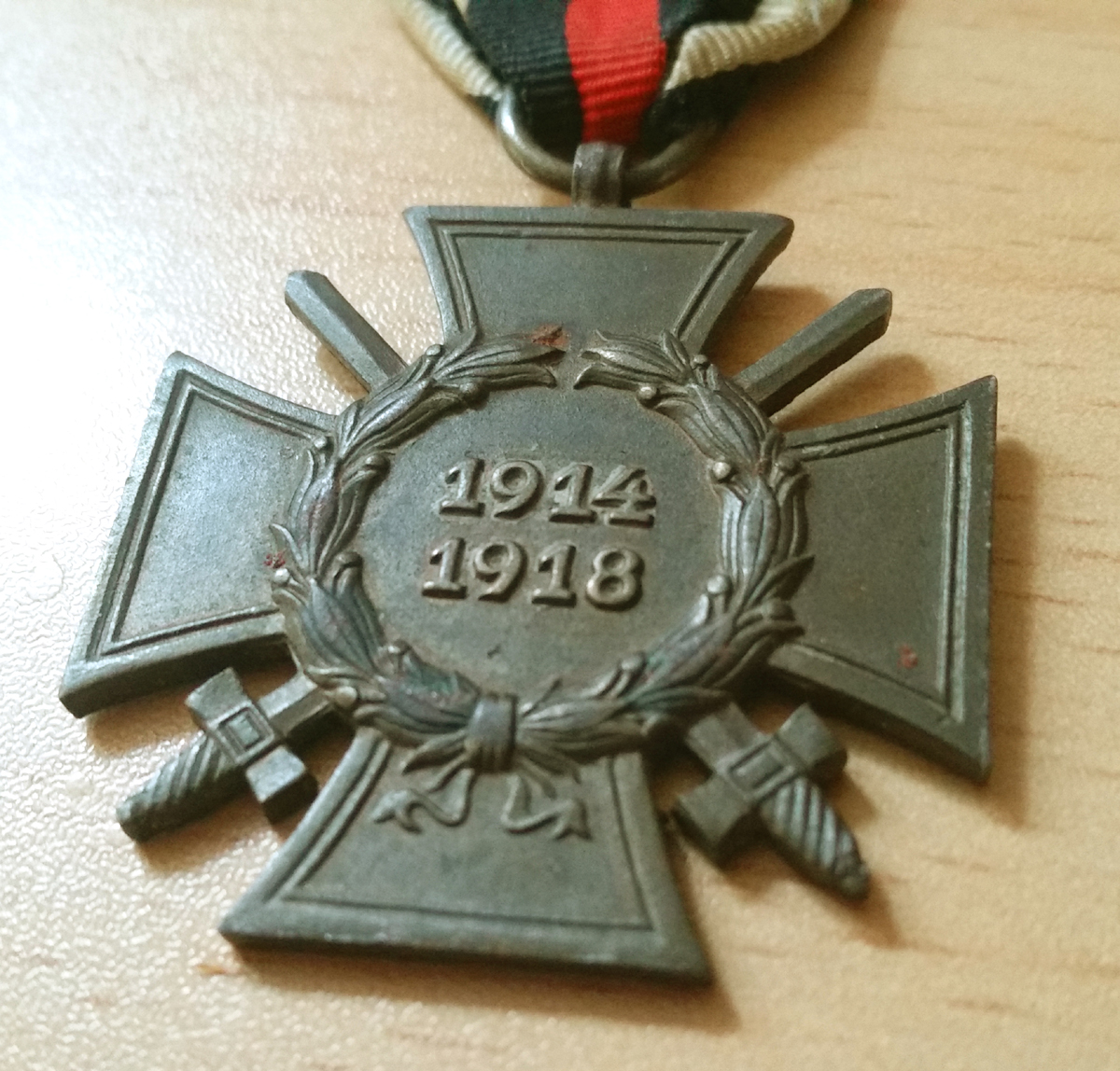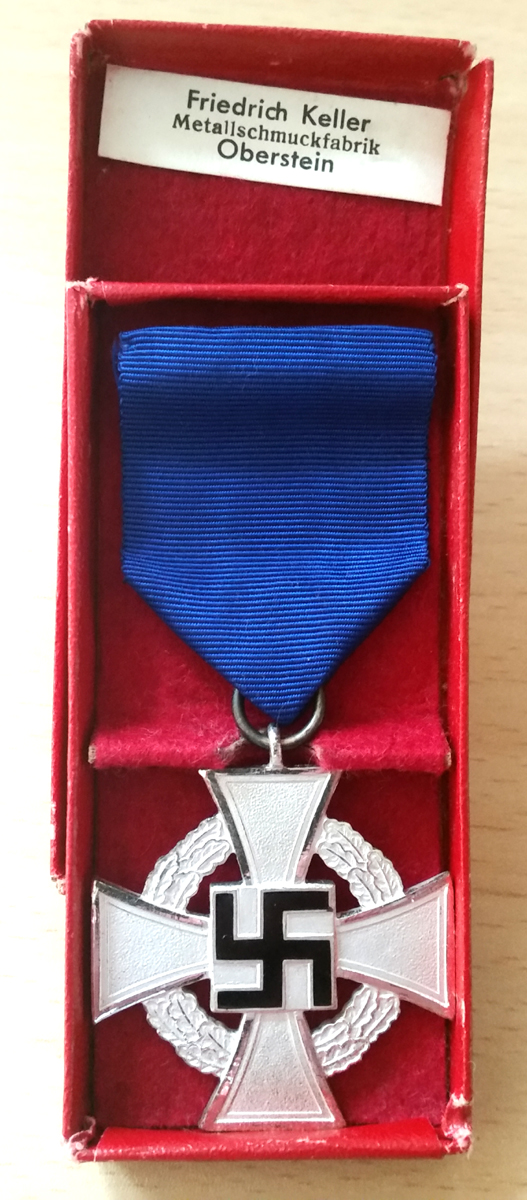MEDALS OF THE IMPERIAL GERMAN EMPIRE & THIRD REICH
(Click any thumbnail image to view full size)
WW1 Mounted Pair - Imperial Iron Cross Second Class with 1914-18 Honour Cross for Combattants
Imperial Iron Cross (EKII - Eisernes Kreuz 2. Klasse) for bravery, heroism or leadership during the Great War. Plus a 1914-18 Honour Cross (Das Ehrenkreuz des Weltkriegs 1914/1918), often referred to as the Hndenberg Cross, with swords to denote a combattant / frontline soldier, makers marked "RSL". Both mounted in the Prussian parade/court style for wear.
The 1914 version of the Iron Cross was instituted by Kaiser Wilhelm II on 5th August 1914. The Iron Cross 1st Class and the Iron Cross 2nd Class were awarded without regard to rank. One had to possess the 2nd Class already in order to receive the 1st Class (though in some cases both could be awarded simultaneously). The egalitarian nature of this award contrasted with those of most other German states (and indeed of many other European monarchies), where military decorations were awarded based on the rank of the recipient. The ribbon for the 1914 Iron Cross (2nd Class) was black with two thin white bands, the colors of Prussia. The non-combatant version of this award had the same medal, but the black and white colors on the ribbon were reversed. During World War I, approximately 5,196,000 EKIIs and 13,000 non-combatant EKIIs were awarded. Exact numbers of awards are not known, since the Prussian military archives were destroyed during World War II.
The Honour Cross was established by Field Marshal Paul von Hindenburg, President of the German Republic, by an order dated 13 July 1934, to commemorate the distinguished deeds of the German people during the First World War. This was Germany's first official service medal for soldiers of Imperial Germany who had taken part in the war, and where they had since died it was also awarded to their surviving next-of-kin. The form of it awarded to combatants (the Frontkämpferkreuz) shows a laurel wreath encircling a medallion, with the dates "1914 1918". Crossed swords are between the arms, while the Honour Cross for non-combatants has no swords and has instead a wreath of oak leaves. Both crosses are in bronze. The Honour Cross for Next-of-Kin (commonly known as the Widows Cross), is black. The application for this award had a time limit, which expired at the end of 1942. Each award came with an Urkunde, or certificate, which indicated which form the award took. The certificates for the next-of-kin crosses came in two types: those for widows were titled Ehrenkreuz für Witwen (Honour Cross for Widows), those for parents Ehrenkreuz für Eltern (Honour Cross for Parents). These certificates were dated and signed, usually by the local police chief or mayor.
WW1 Honour Cross for Next-of-Kin (aka Widows Cross) - with makers mark "G20"
The Honour Cross for Next-of-Kin (commonly known as the Widows Cross).
WW1 Honour Cross with Swords (for Combattants) - with makers mark "G7"
Imperial Iron Cross Second Class - EKII - with maker's mark "R.W"
Imperial Iron Cross (EKII - Eisernes Kreuz 2. Klasse) for bravery, heroism or leadership during the Great War. Makers marked "S.W" on the suspension ring.
Third Reich era - 25 year Civil Faithful Service Medal
In original award box, maker's marked "Friedrich Keller". The Civil Service Faithful Service Medal (Treudienst-Ehrenzeichen für Beamte Angestellte und Arbeiter im öffentlichen Dienst) was a Nazi Germany medal that was founded on 30 January 1938, in two grades, to reward civilians in the employ of the German public services for long and faithful service. All civil service officials, employees, and laborers at any level of the public service (local, regional or national) who complete 25 years service were eligible for this, second class silver award. The reverse is stamped with 'Für Treue Dienst' (For Faithful Service). The ribbon for the medal is cornflower blue.
Third Reich era - Cross of Honour of the German Mother - 1st Class
In near mint condition in original award box, maker's marked "A. Rettenmaler - Schwab, Gmund". Gold award, for eight or more children.
The Ehrenkreuz der Deutschen Mutter (Cross of Honour of the German Mother), referred to as the Mutterehrenkreuz (Mother’s Cross of Honour) or simply Mutterkreuz (Mother’s Cross), was a state decoration and civil order of merit conferred by the government of the German Reich. It was presented between 1939 and 1945 to Reichsdeutsche mothers (which included ethnic German mothers from areas such as Austria and the Sudetanland) exemplary motherhood, showing high moral values. It is based on a similar award which began in France in the 1920s, and continues to the present day, the Médaille de la Famille Française. The award was introduced by decree in Berlin on 16 December 1938 by the Führer und Reichskanzler Adolf Hitler.
It was awarded in three classes. 3rd Class (bronze) - for four to five children, 2nd Class (silver) - for six to seven children and 1st Class (gold) for eight or more children. It was by no means easy to obtain, even if you did meet the criteria for the number of children conceived and raised. A recommendation (presented collectively at the beginning of each month to the Presidential Chancellery in Berlin, could only be instigated by the local mayor’s office, or on application from the local NSDAP Party leader, or the District Warden of the Reichs Union of Children-rich families.
The nomination involved a lengthy and exhaustive bureaucratic process. Characteristics of both the mother and grandparents were observed and eligibility studied thoroughly. The conferral of the Mother’s Cross was so highly regarded by the government in Berlin, that additional bureaucratic resources assigned to lesser civil and military decorations were pulled for the exhaustive administrative procedures that this decoration alone required. Such was it's importance, that during Germany’s wartime period, all other civil honours and decorations except the Mother’s Cross were temporarily suspended. Local government agencies such as the Social Welfare Agency, Public Health Department, Youth Welfare Agency, Police and other government agencies were all consulted in the eligibility investigation process. The decoration could and was only to be bestowed to the most honourable proven mothers. Accordingly, the following legislative prerequisites were to be strictly met:
1) Both parents were of German blood and genetically-fit - Evidence to be provided by the mother in the form of a signed declaration "that the mother – and her husband – is/are of German blood-heredity, that their four grandparents are not of Jewish or other foreign ethnic origin, nor have ever belonged or subscribed to the Jewish religion."
2) That the mother was indeed worthy of the award - Proven an honourable mother of reputable moral standing, genetically healthy and genetically-fit. With no evidence of prior confinement to a state penitentiary, marital infidelity, unlawful abortion, or any other personal burdens of taboo or social offences such as prostitution or promiscuous behaviour or intimate interracial relationships.
3) The children were live births - and that the children are clear of hereditary illnesses or genetic disorders, that a conscious responsibility exists without supervision in the parents being mindful of maintaining the family home to acceptable orderly standards and to nurturing their children towards being useful compatriots. The husband had not served a prison sentence, the family were not conceiving a great number of dependants for significant monetary gain from state child support to avoid regular employment, the family members were not chronic alcoholics, work-shy nor had conflicts with the law and police or presented other social delinquencies, and the family were not burdening private or public social welfare aid.
Recipients of the Mother's Cross were treated like royalty in public. People would give up seats on busses and trams for them, and they rarely waited in line at shops, bakeries, butchers, etc. Theywere also given preferential treatement when it came to housing, benefits and healthcare.
The award was not a lifelong award as such. It could be annulled if the mother ceased to be "worthy", for example by neglecting her children, marital infidelity, or exhibiting any other behaviour deemed "problematic".
 The Invicta Medal Museum (Online)
The Invicta Medal Museum (Online) 
















.jpg)
.jpg)
.jpg)